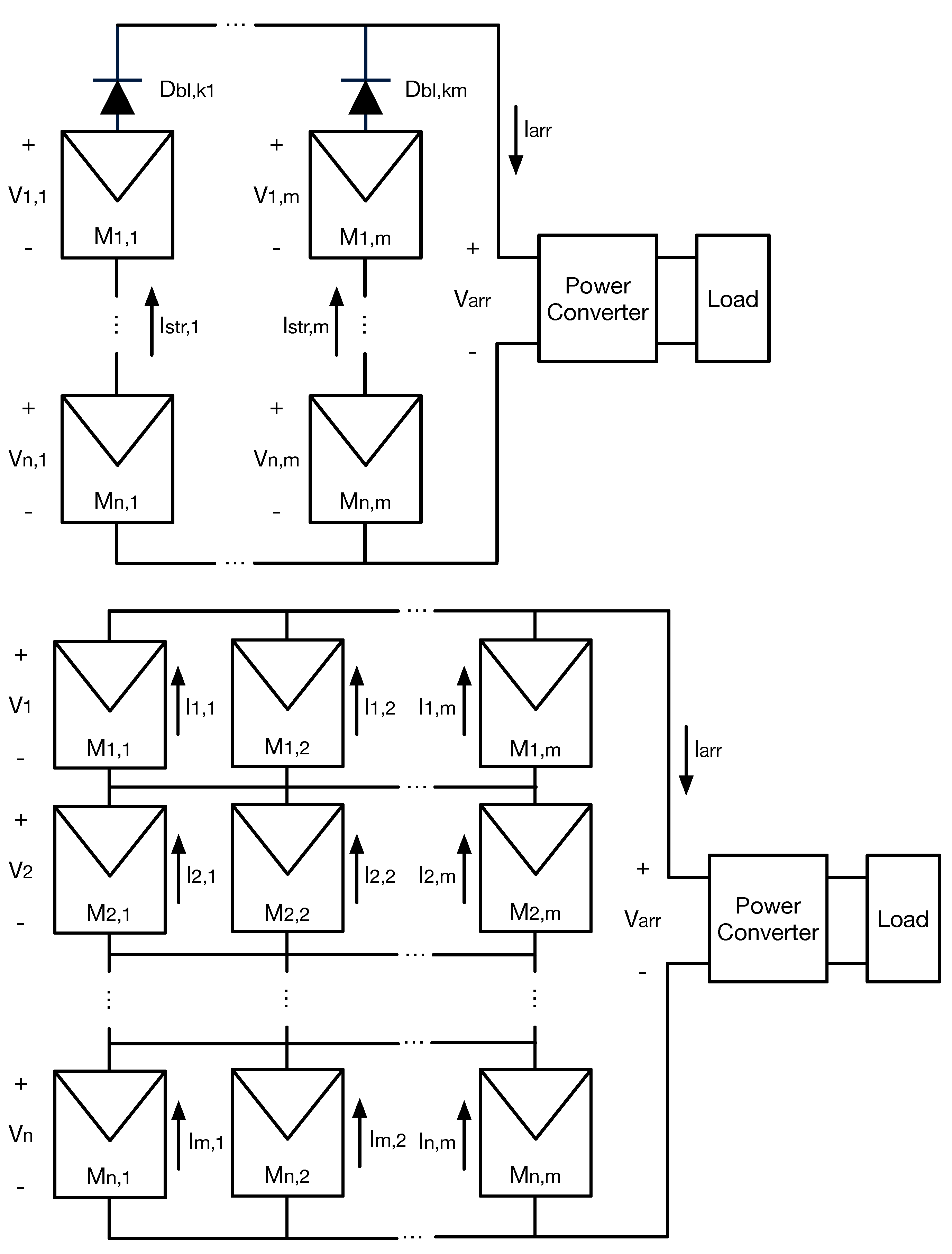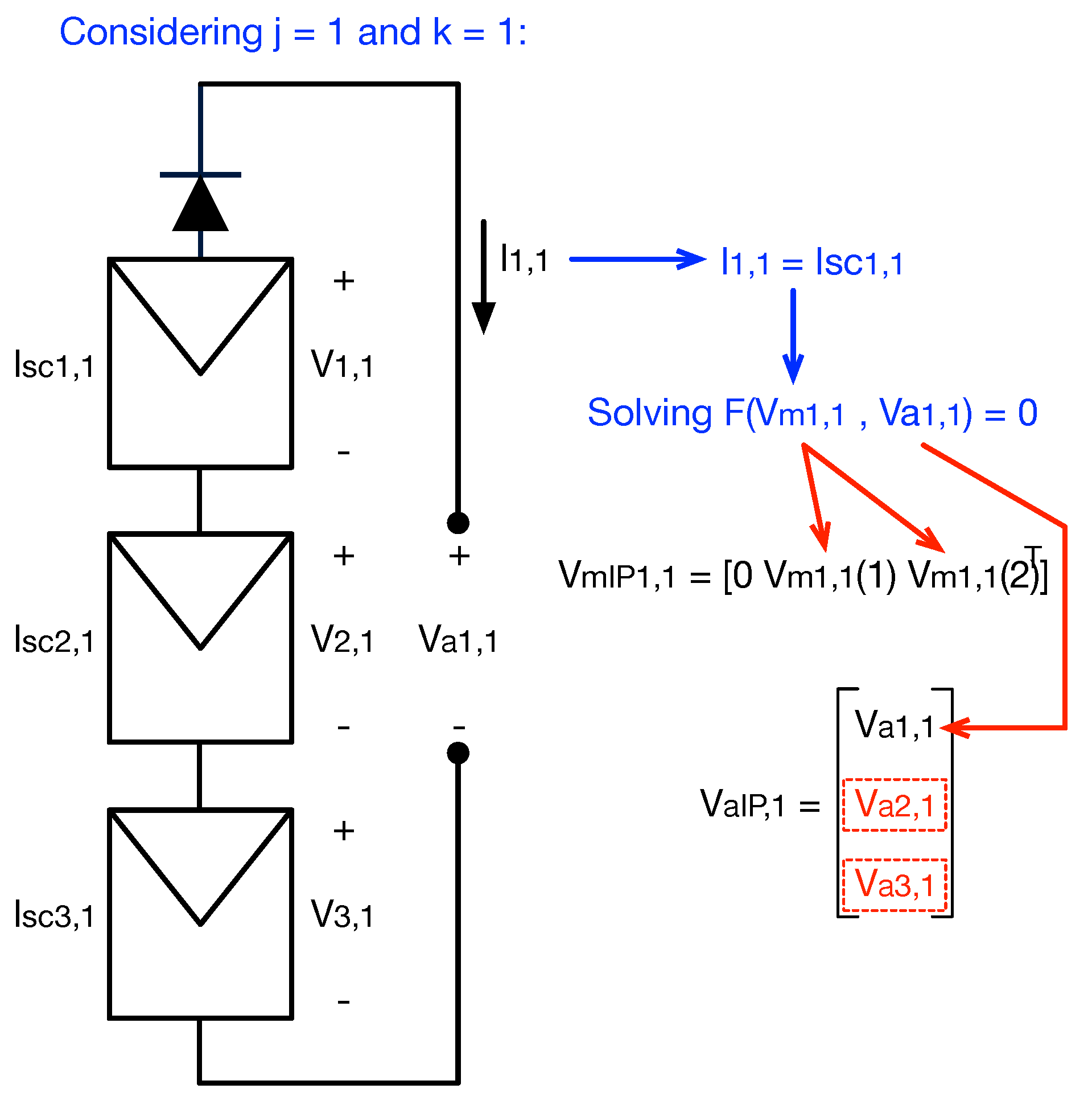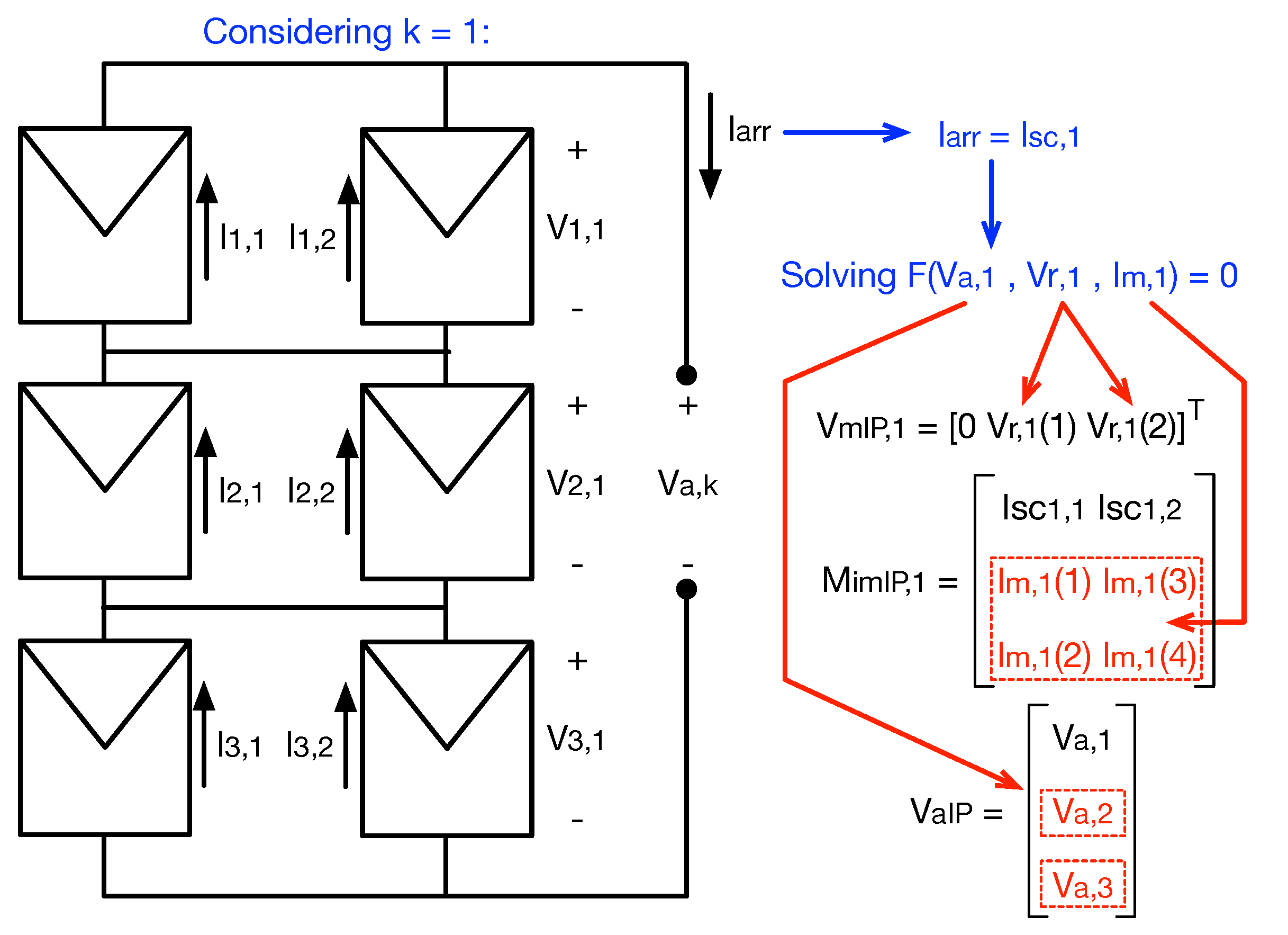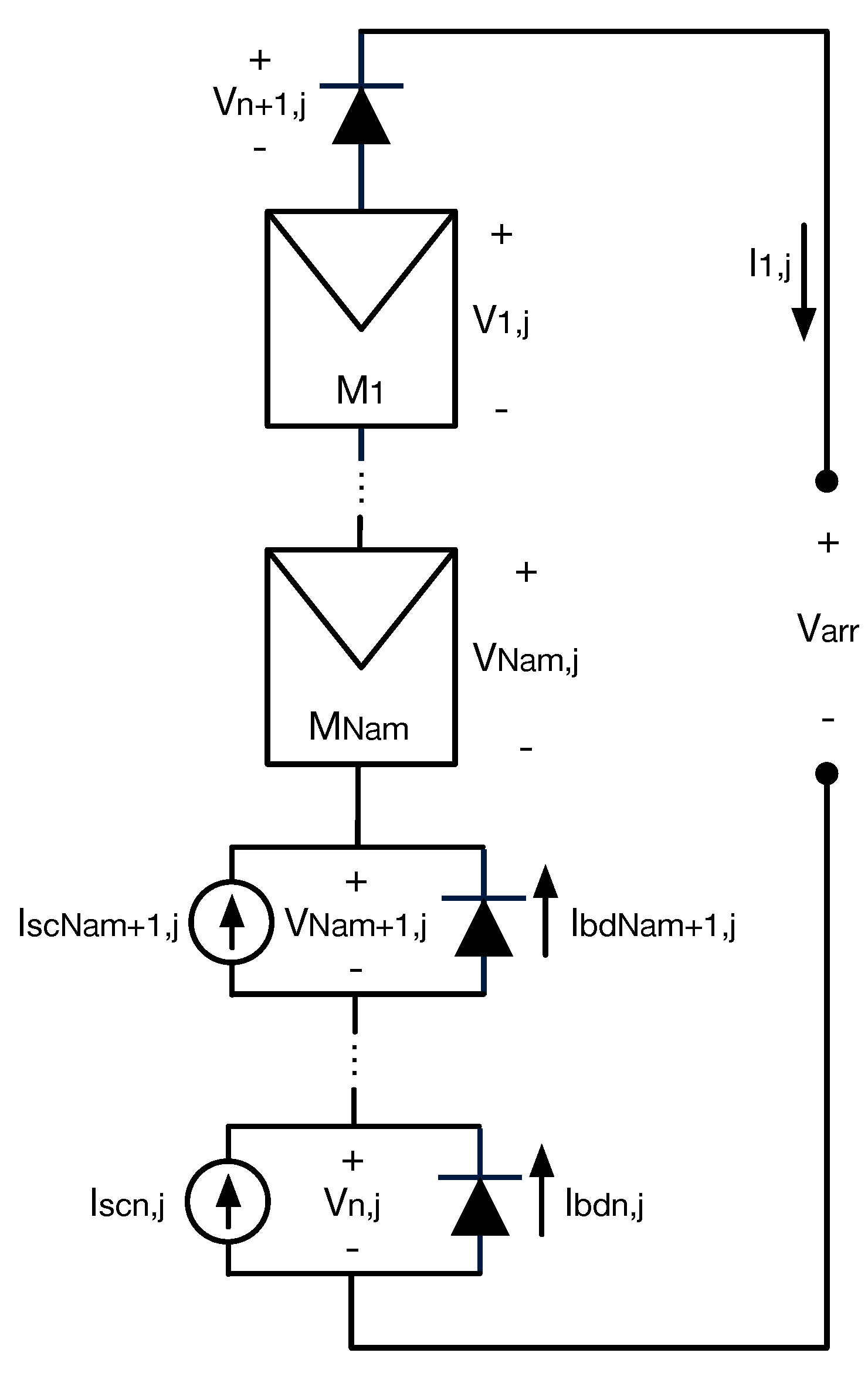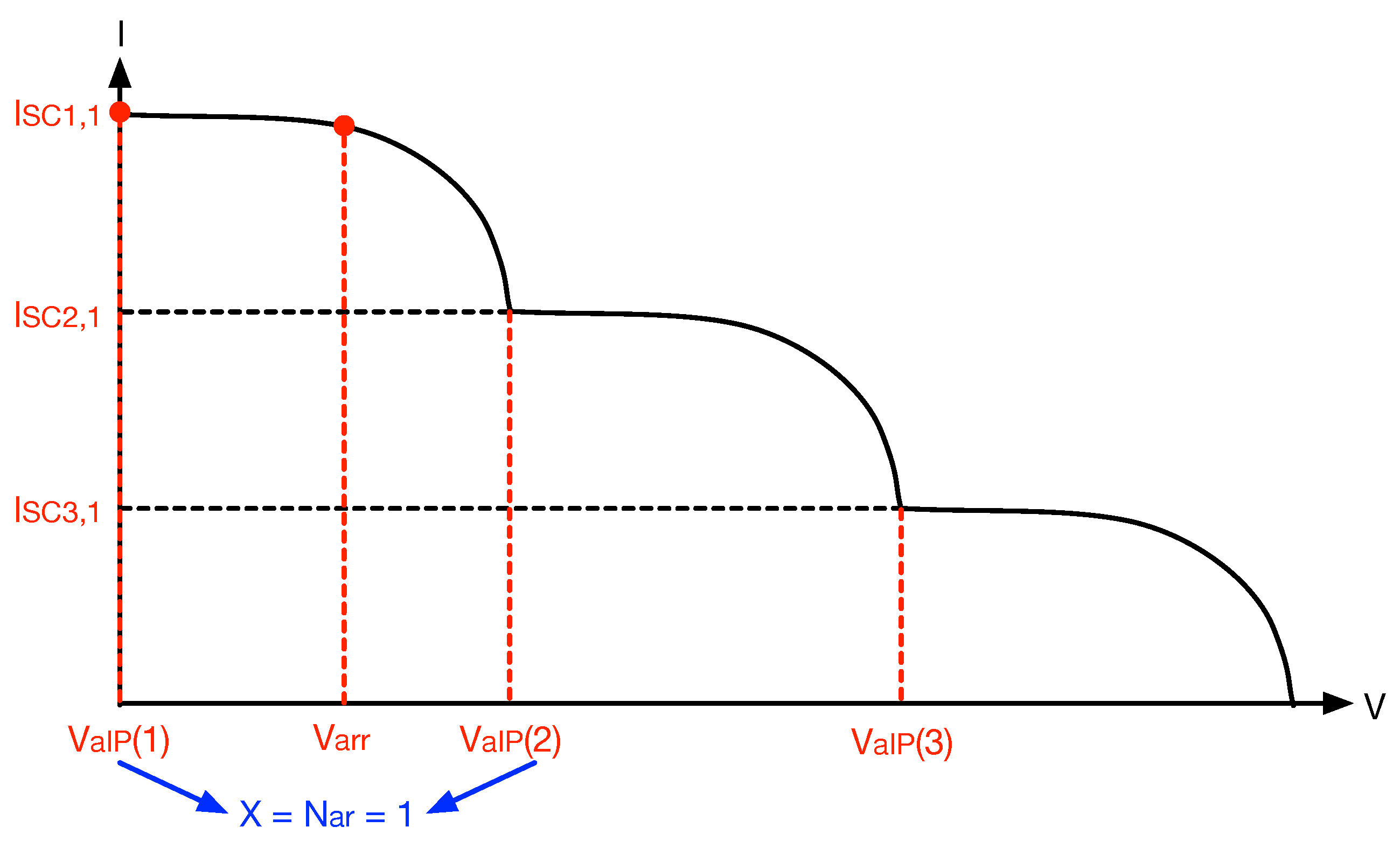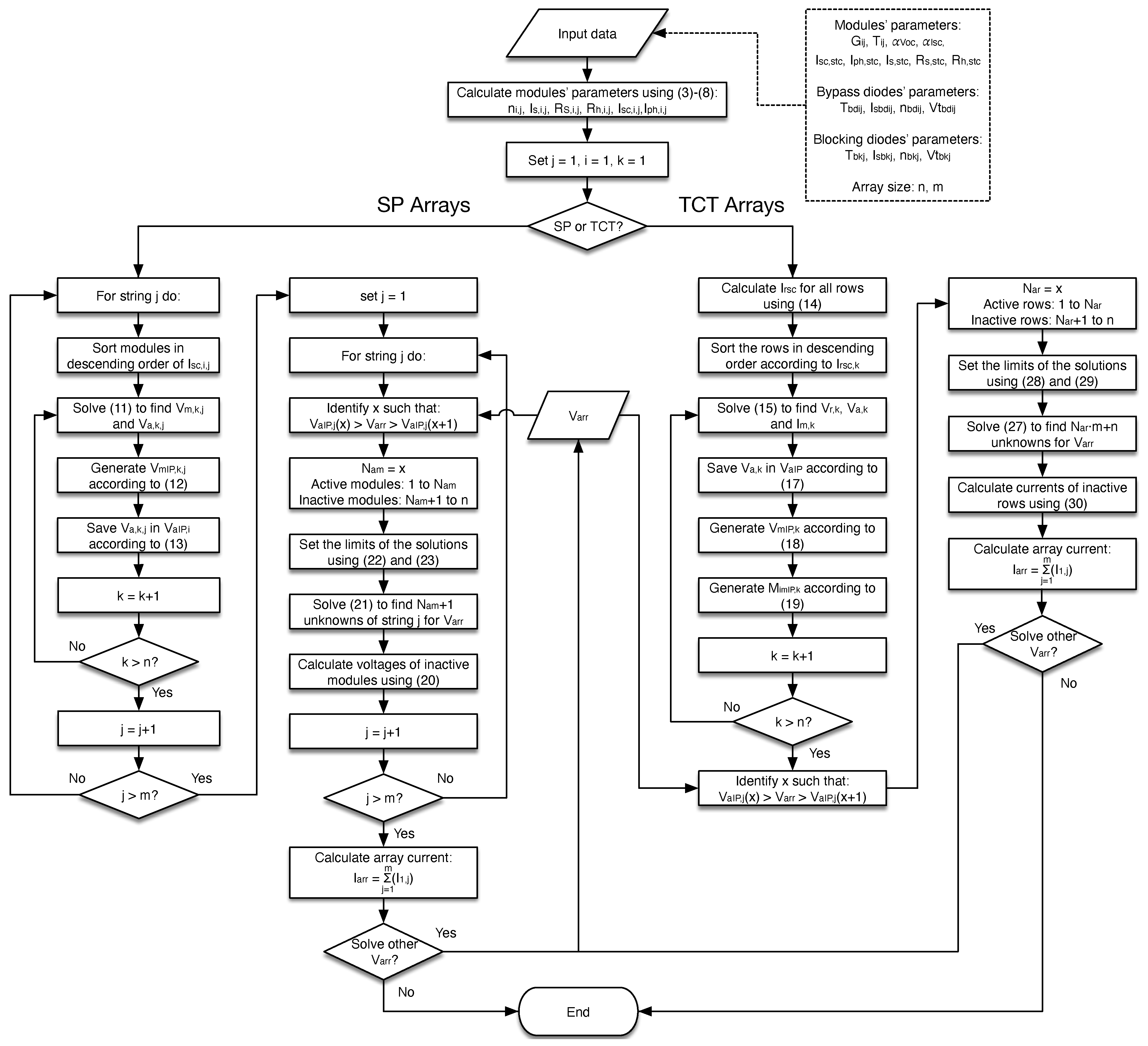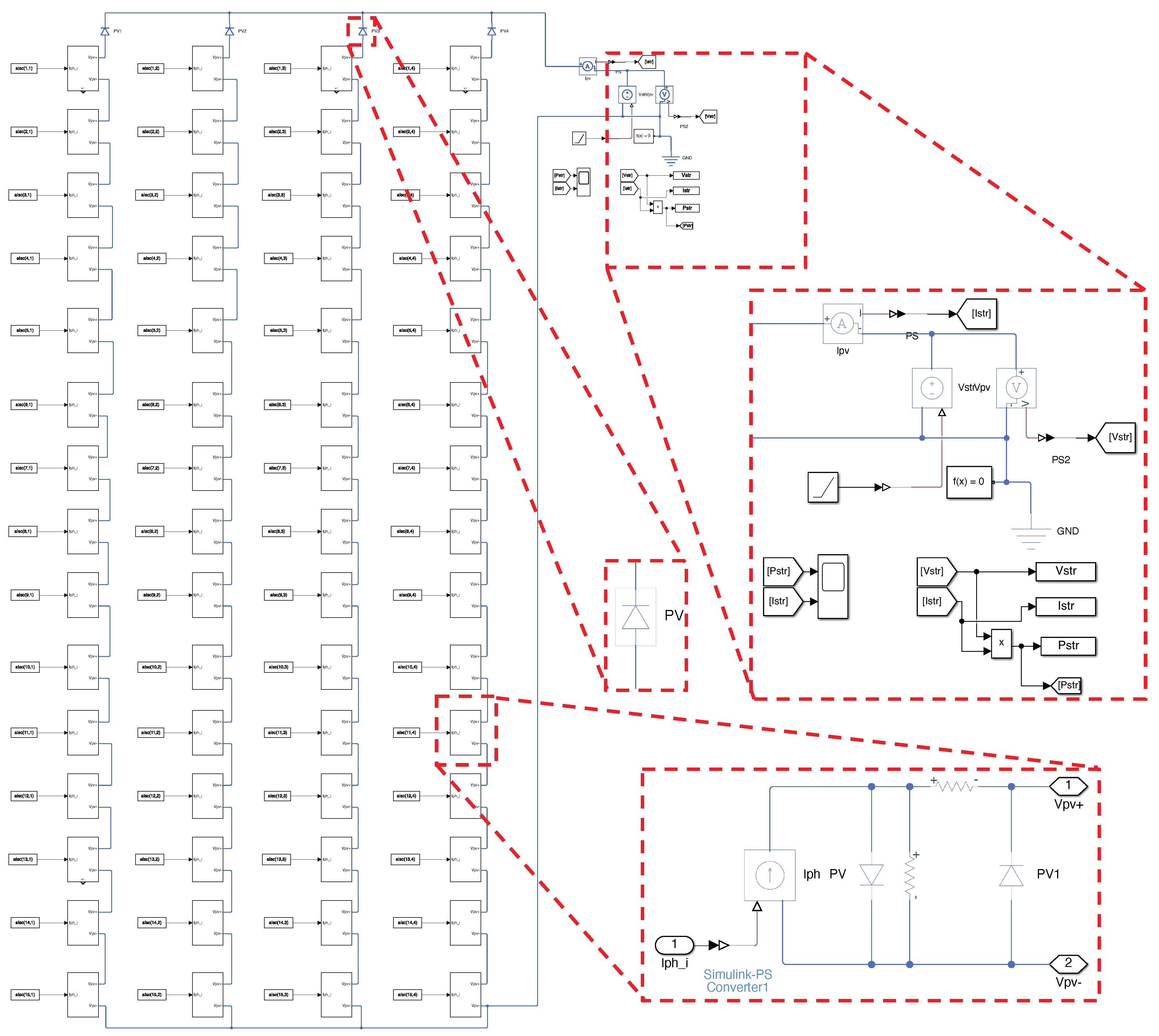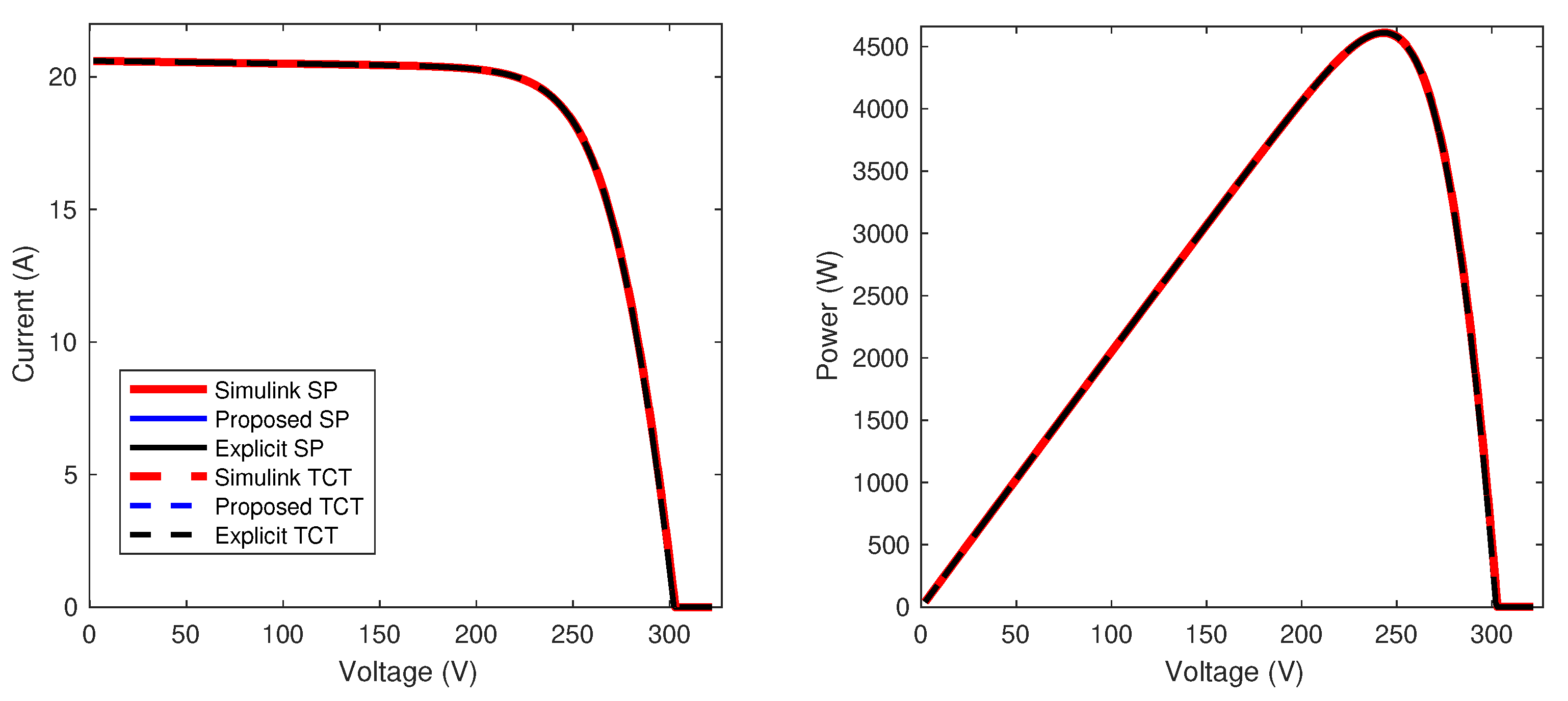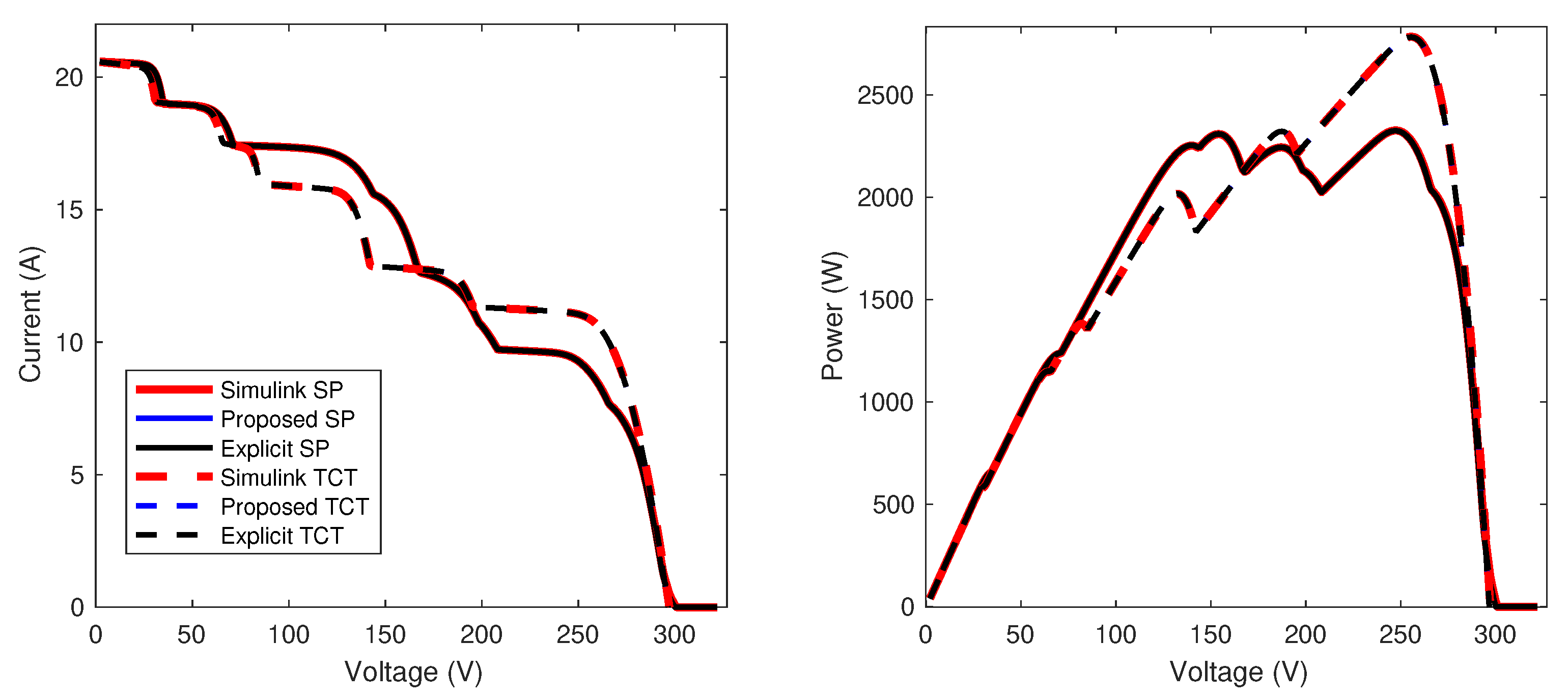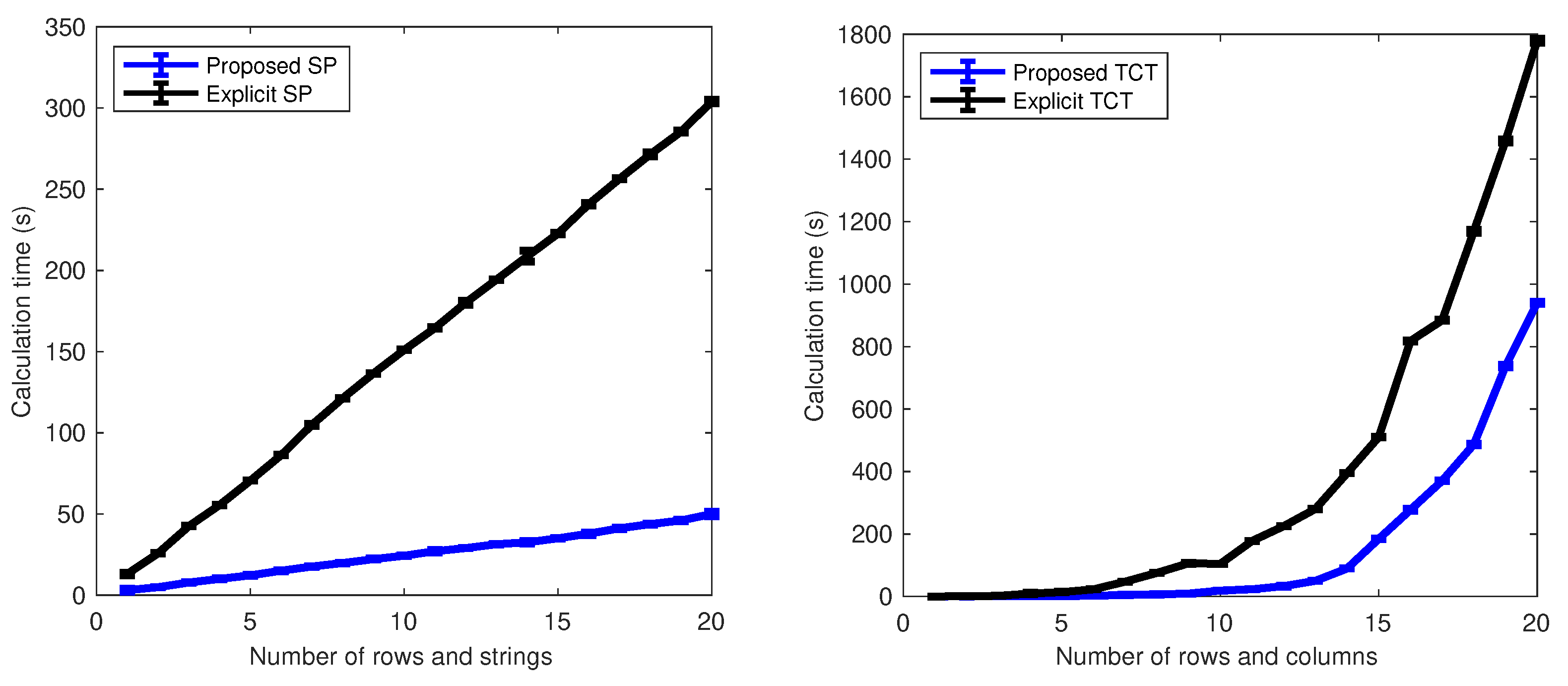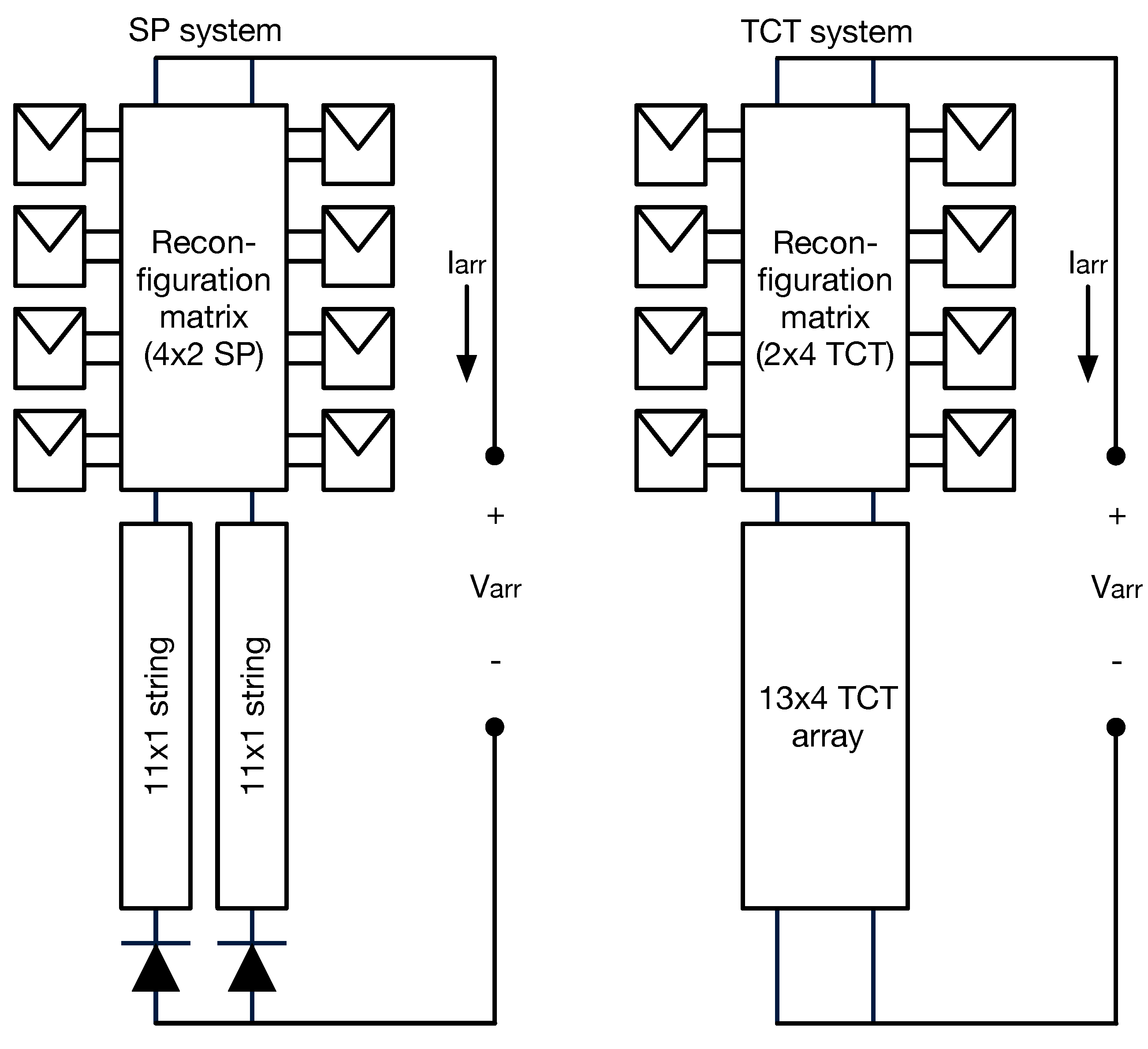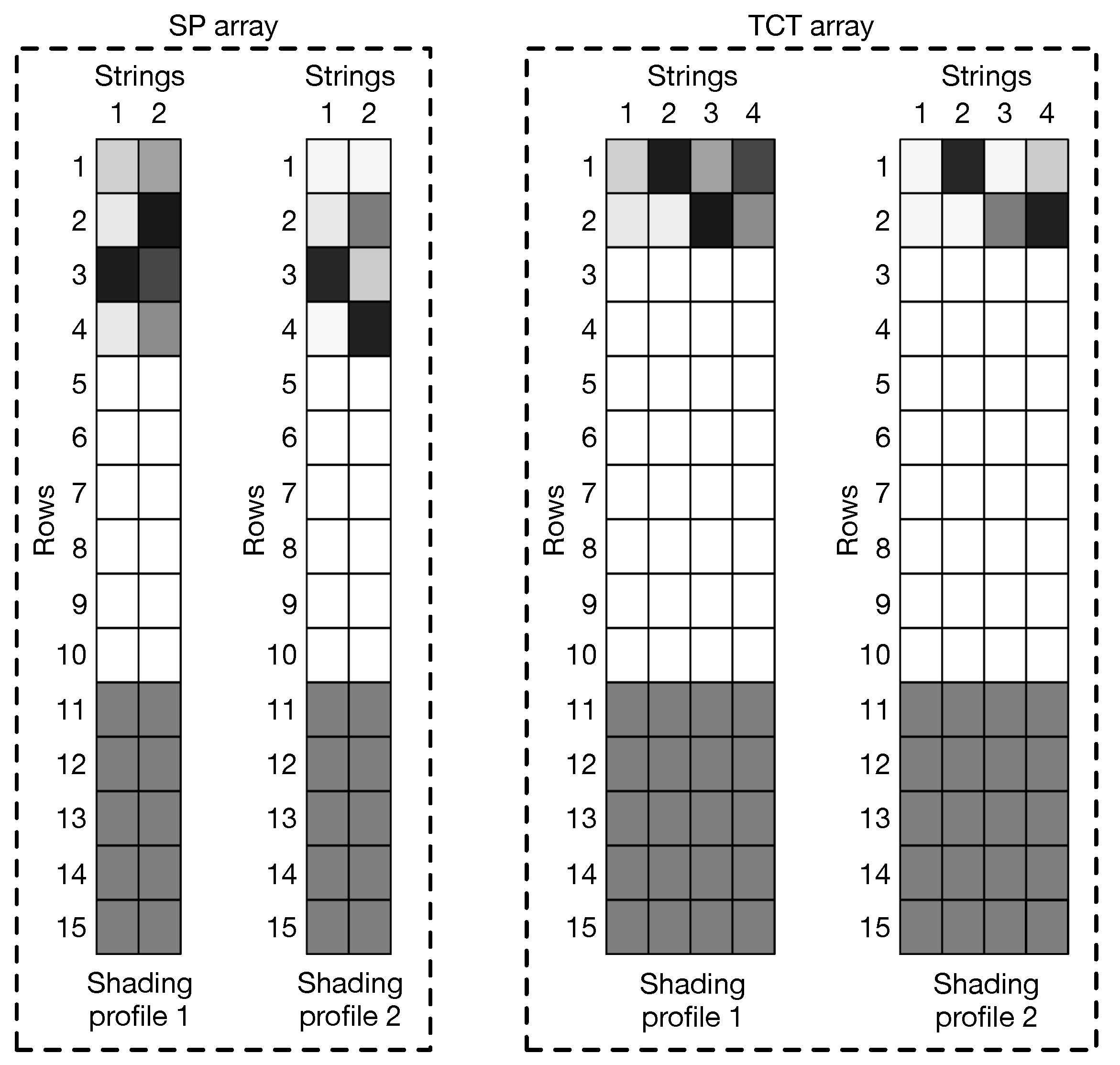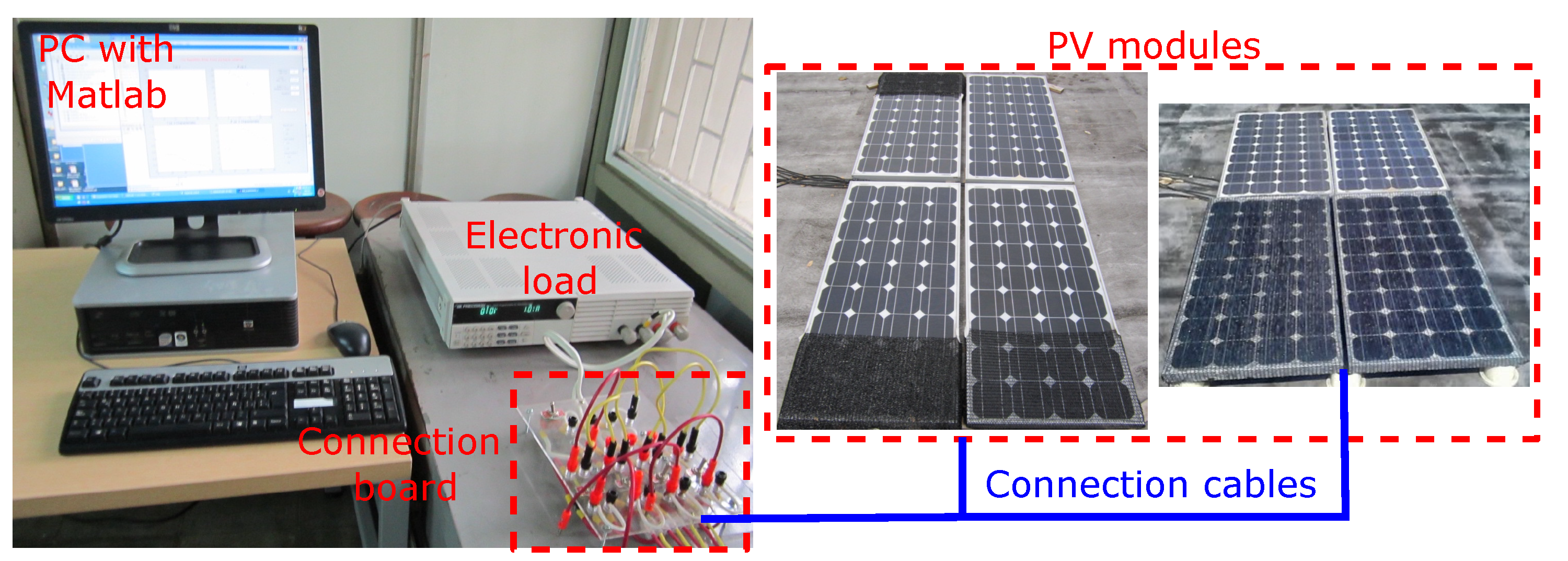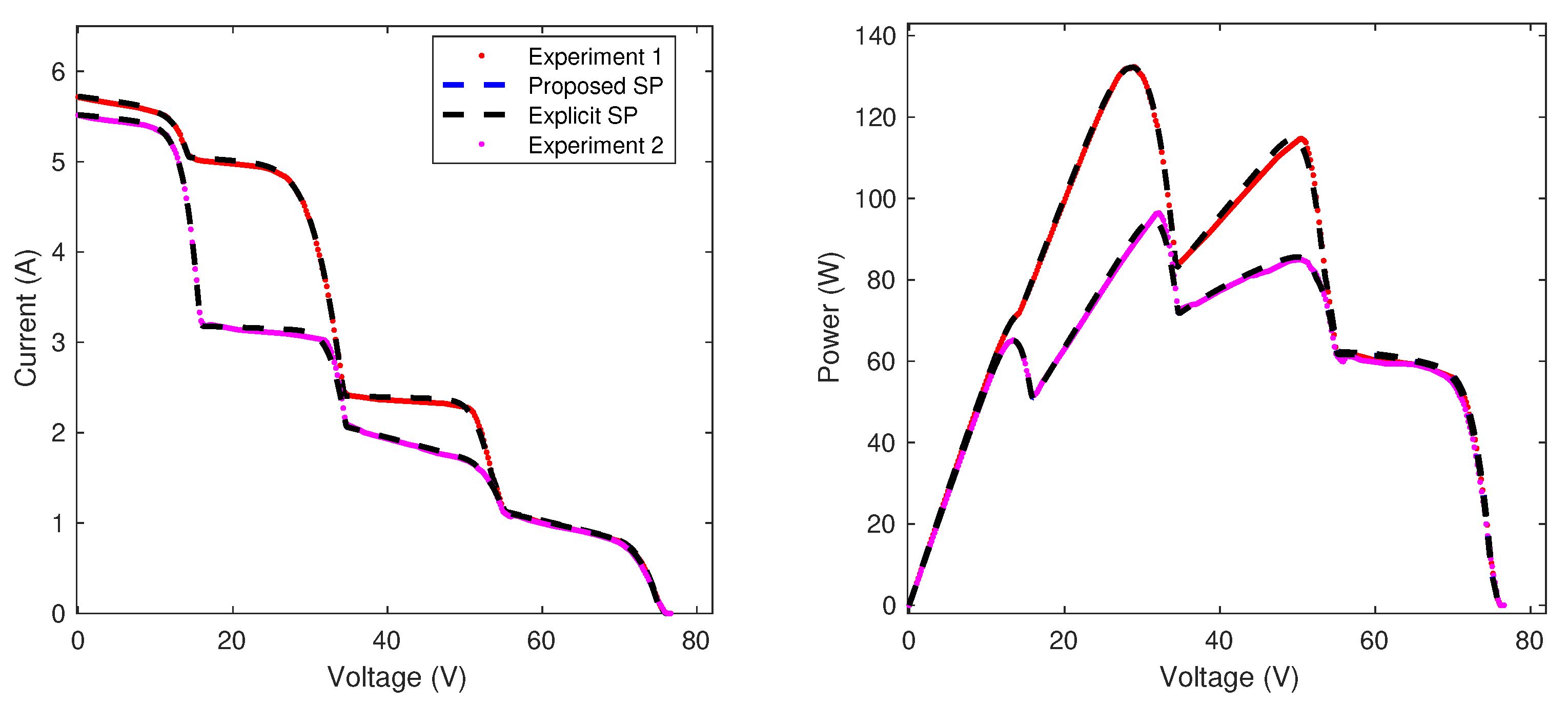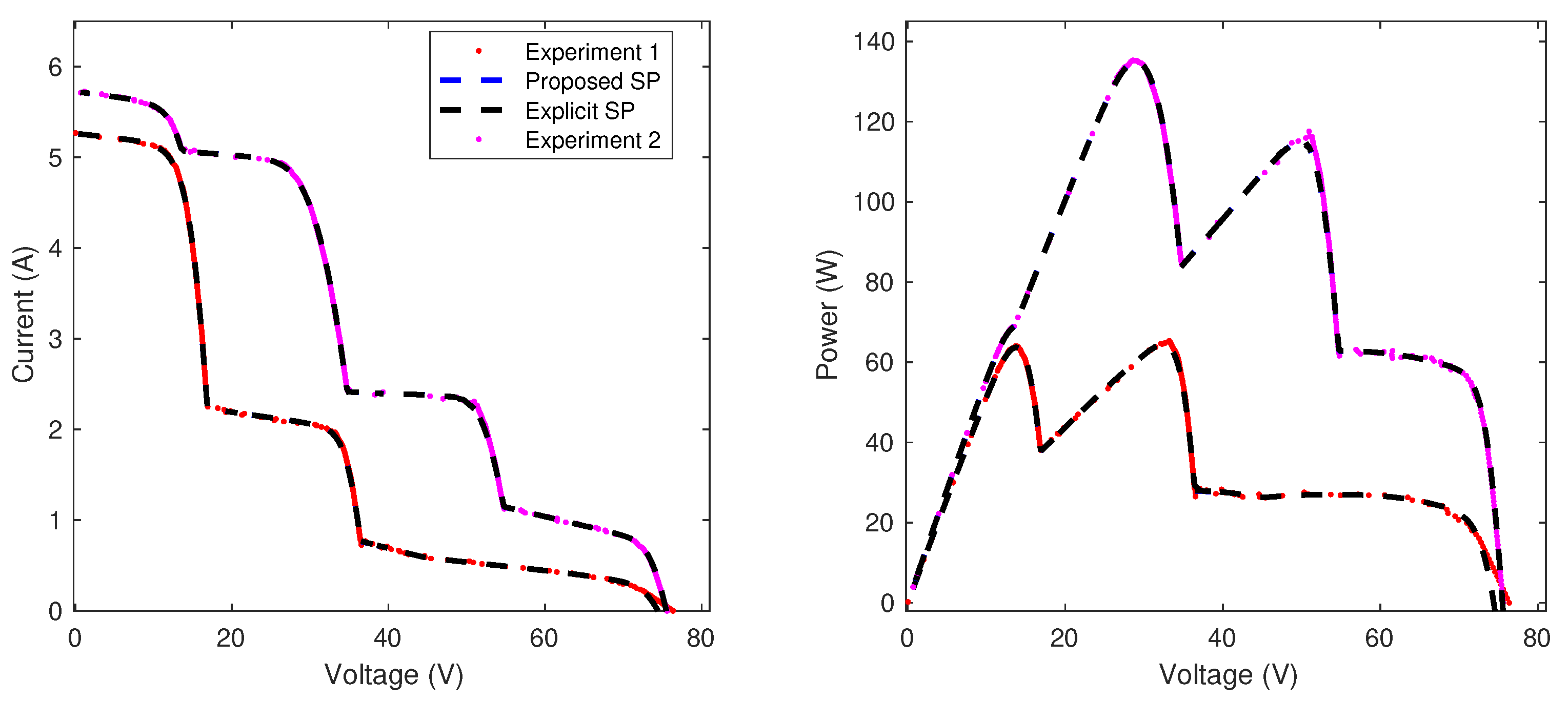1. Introduction
Photovoltaic (PV) generators have been established as one of the main renewable energy sources adopted to contribute to the decarbonization of electric energy generation around the world. That is why the International Energy Agency estimates that 240 GW of PV systems were installed in 2022 to reach a global capacity of 1185 GW. Although such an installed capacity is saving around 1399 million tons of CO
eq, it is expected that PV generators continue growing to reach the goals proposed in COP21 [
1].
Because of the increase in PV generators used in electrical systems, the number of applications that use this source is continually increasing. Water pumping systems [
2], hybrid generator systems composed of PV arrays, wind generators, batteries [
3,
4], and PV generators connected to electric grids [
5] are very popular. Each application has requirements in control, management, and modeling to operate safely and efficiently. To improve the efficiency of PV generators, maximum power point trackers are developed and applied to the PV arrays [
6], and their safe operation is guaranteed using optimized control systems [
7]. To analyze the high number of applications of PV generators, several models with several levels of representation are required. The next step is to analyze the multiple connections of PV arrays and the strategies to model them.
PV arrays can be connected in series-parallel (SP), total-cross tied (TCT), or other configurations. SP is the typical connection used in commercial arrays, and TCT may mitigate the power reduction produced by mismatching conditions (e.g., partial shading) [
8,
9]. In SP arrays, the number of modules in each string (
n) depends on the input voltage required by the PV inverter (or dc/dc converter), while the number of strings connected in parallel (
m) is defined according to the power required from the array and considering the power limitations of the inverter (or load). In addition, in SP arrays each string has a diode connected in series, named the blocking diode, to avoid the reverse current through the modules in the string [
10]. On the other hand, an
TCT array corresponds to
n rows connected in series, where each row is formed by
m modules connected in parallel. This configuration does not require blocking diodes and, in some cases, mitigates the power reduction produced by non-uniform conditions, which means that not all of the PV modules operate at the same irradiance and temperature and that not all of the PV modules have the same electrical characteristics. However, one disadvantage of TCT arrays is that they require additional wiring [
11].
SP and TCT arrays can be modeled as an equivalent circuit generated by the interconnection of the equivalent circuits that represent each module. When an array is operating under non-uniform conditions, it is necessary to solve the equivalent circuit that represents the array’s electrical behavior, which depends on the model adopted to represent each module [
10].
The single-diode model (SDM) is the most widely used model of PV modules and provides a satisfactory compromise between accuracy and complexity [
10]. In this model, the relation between the module’s voltage (
V) and current (
I) is given by an implicit equation. Therefore, some models proposed in the literature use the Lambert-W function to obtain
I as an explicit function of
V [
12], while others use the implicit equation [
13]. Therefore, the mathematical models of SP and TCT arrays are divided into two main groups: explicit and implicit. Nonetheless, several published works do not use mathematical models of the PV arrays; instead, they solve the PV array equivalent circuit in a circuit simulator [
14]. Although the use of circuit simulators to model PV arrays facilitates the modeling of arrays in different configurations, it is not practical when it is required to continuously modify the model parameters, the partial shading conditions, or the array dimensions, which are needed to perform energy production analysis or implement the reconfiguration of controllers.
The objective of the mathematical model of an
SP array is to determine the voltages of all of the modules, the string currents, and the array current (
), which correspond to the sum of all of the strings currents. To reach that objective, each string can be analyzed independently for a given array voltage (
) that is defined by the PV inverter. The explicit models proposed in [
12,
15,
16] use the SDM to represent each module and define a system of nonlinear equations
for each string, where the
unknowns correspond to the voltages of the
n modules and the blocking diode. In [
12], the authors introduce the Jacobian matrix (
J) related to the system of nonlinear equations and use
and
J to calculate the unknowns by applying an iterative solution method in Matlab. Later, the authors of [
15] proposed a method to calculate the inverse of
J symbolically, which speeds up the solution of
using the Newton–Rapson method. Moreover, that paper also proposes a procedure to determine the guess solution to facilitate the convergence of the Newton–Rapson algorithm. Additionally, the authors of [
17] evaluated both deterministic and metaheuristic optimization algorithms to solve
, concluding that the deterministic ones provided the best results for this problem.
In [
16], the authors propose a different explicit approach to model each string of an SP array. The unknown variable is the string current, and the voltage of each module is expressed in terms of the module current by using the Lambert-W function, while the bypass diodes are modeled with the piecewise linear model. Moreover, that paper proposes a method to calculate the inflection voltages in the current vs. voltage (I-V) curve to identify when a module is active or inactive due to the action of the bypass diode, thus simplifying the model of inactive modules to reduce the complexity of the nonlinear equation of the string.
The other mathematical models of the
SP arrays consider the SDM without series and parallel resistors (i.e., ideal SDM) to reduce the complexity of the system of nonlinear equations, and, as consequence, the computational burden and calculation time are reduced. An interesting model of this type is the one introduced in [
18], where the authors represent each bypass diode as an ideal diode, using the inflection voltages of the I-V curve to reduce the complexity of the system of nonlinear equations that represent each string.
The implicit mathematical model of an
SP array, introduced in [
13], uses the implicit equation that describes the I-V relationship in the SDM. Then, the model defines a system of
nonlinear equations (
) and the same number of unknowns for each string, which correspond to the string current and the voltages of the
n modules and blocking diode. This model avoids the evaluation of the Lambert-W function, which reduces the computational burden of the iterative solution method of
and, as consequence, reduces the calculation time required to solve
regarding the explicit models with SDM. Furthermore, in [
19] the authors evaluated deterministic and metaheuristic optimization algorithms to solve
and found that deterministic options show better performance in different cases.
Regarding the models of an
TCT array, the objective is to determine the currents of all of the modules; the voltages of the rows; and the array current, which corresponds to the sum of the modules’ current in one row. In the literature, there are some mathematical models for
TCT arrays [
20,
21] and others for arrays with particular dimensions such as
[
22,
23] or
[
24]. In addition, some of those models use the SDM [
20,
24], the SDM without the parallel resistance [
23], or the SDM without series and parallel resistors (i.e., ideal SDM) [
20,
22]. Moreover, some models focus on particular shading patterns [
22,
23,
24], while others can be applied to any shading condition [
20,
21].
The models proposed in [
20,
21] define a system of nonlinear equations that represent the TCT, and their main difference is that one model uses the ideal SDM [
20], while the other one uses the SDM. Additionally, in [
20] the authors propose a method to calculate the inflection points in the I-V curve when a row is active or inactive, which enables one to neglect such a row in the analysis, thus simplifying the system of nonlinear equations. Instead, in [
21] the authors propose a procedure to explicitly determine the inverse of the Jacobian matrix associated with the system of nonlinear equations that describe the array; hence, the solution of the system of nonlinear equations can be sped-up with iterative methods such as the Newton–Raphson.
In the models previously described, there are two strategies to reduce the calculation time of the models that use the SDM to represent each module. The first one is the use of the inflection voltages of the I-V curves to identify the active bypass diodes (i.e., inactive modules in SP arrays and inactive rows in TCT arrays); then, the inactive modules or rows can be represented with simplified models that reduce the complexity of the system of nonlinear equations describing the arrays. The other strategy is to use the implicit equation of the SDM to avoid the evaluation of the Lambert-W function, which reduces the computational burden required to solve the system of nonlinear equations. However, the models that use the inflection voltages use the Lambert-W function to represent each module of the array, which increases the calculation time, while the models that use implicit equations to avoid using Lambert-W function do not use the inflection voltages to simplify the system of nonlinear and implicit equations that represent the array, which augments the computational burden. Those increments in the calculation times restrict the application of those models in applications where this indicator is critical, such as reconfiguration systems.
The objective of this paper is to propose mathematical models for SP and TCT PV arrays based on the implicit equations of the SDM and the inflection points of the current–voltage curves. These models reduce the calculation time by reducing the complexity of the nonlinear equation systems that represent each string of SP arrays and the whole TCT array. Specifically, two approaches are used to reduce the complexity of the implicit models of SP and TCT PV arrays; the first approach is the simplification of the system of nonlinear and implicit equations, which is based on the fact that the modules or rows, for TCT, with active bypass diodes can be represented by a current source in parallel with the bypass diode, which can be represented by explicit equations. The second strategy is the definition of restricted search spaces for the solution of the simplified system of nonlinear and implicit equations. This is achieved by using the voltages and currents for each IP, which define a specific search range for each unknown voltage or current, thus reducing the solution time of the numerical method that solves the system of equations. Consequently, the calculation process that solves the model significantly speeds up in comparison with processes that solve traditional explicit models based on the Lambert-W function. For example, in several simulation scenarios with multiple array sizes, the proposed SP model is faster than the traditional solution, reducing the computation time by . On the other hand, the proposed TCT model provides a reduction time between and for arrays larger than . For dynamic reconfiguration purposes, where both SP and TCT arrays were partially reconfigured to improve power production under two partial-shading conditions, the results demonstrate that the proposed solution provides the same optimal configuration but more than 7 times faster for SP reconfigurations, and between 4 and 6 times faster for TCT reconfigurations.
The rest of the paper is organized as follows:
Section 2 explains the structure of SP; the TCT arrays; the SDM equations; and the parameters, as well as their dependence on the irradiance and temperature. Then,
Section 3 introduces the proposed procedure to determine the inflection voltages and currents by using the implicit equations for both the SP and TCT arrays. Later,
Section 4 introduces the proposed implicit models of SP and TCT arrays and describes the use of inflection voltages and currents to reduce the complexity of the system of nonlinear equations that represents the arrays; also, the section presents a comprehensive flowchart describing the complete model processing. Subsequently,
Section 5 demonstrates the validity and accuracy of the proposed models for arrays with different dimensions through simulation and experimental results. This section includes two practical applications for dynamic reconfiguration purposes, which illustrate the practical advantage of the reduction in the calculation time obtained with the proposed model. Finally, the conclusions close the paper.
2. SP and TCT Arrays
The general structure of
PV arrays in SP and TCT configurations is illustrated in
Figure 1. On the one hand, SP arrays are formed by
m strings (or columns) connected in parallel, where each string is formed by
n PV modules (black rectangles) and one blocking diode (
) connected in series. On the other hand, TCT arrays are formed by
n rows connected in series, and each row has
m PV modules connected in parallel. In both configurations,
n depends on the minimum and maximum input voltage of the power converter, while
m is defined according to the maximum power required by the load and supported by the power converter. In a PV system, the power converter modifies the array voltage (
), and, as consequence, the PV array delivers a particular current (
), which depends on the irradiance and temperature of the modules as well as the modules’ parameters. Therefore, the main objective of a PV array model is to determine
for a given value of
. However, it is necessary to determine other arrays’ variables (voltages and currents) before calculating
; thus, the following subsections describe the implicit model used to describe the electrical behavior of a PV module and a blocking diode (
Section 2.1), and the PV array’s parameters and variables (
Section 2.2).
2.1. Models of PV Modules and Blocking Diodes
The single-diode model (see
Figure 2) is one of the most widely used representations to reproduce the electrical behavior of PV modules, which is considered as a set of
series-connected cells with a bypass diode (BD) connected in antiparallel. The single-diode model is formed by an independent current source (
) that describes the photovoltaic effect, a diode (D) that describes the nonlinear behavior of the
PV cells, a resistor in parallel (
) to include the leakage currents, and a resistor in series (
) to consider the ohmic losses. Applying Kirchhoff’s current law (KCL), it is possible to obtain the implicit expression of the module’s current (
I) and voltage (
V) shown in Equation (
1) [
13], where
,
, and
are the inverse saturation current, ideality factor, and thermal voltage of diode D, respectively, while
is the bypass diode’s current, which is defined in the explicit equation Equation (
2). In this last expression,
,
, and
represent the inverse saturation current, ideality factor, and thermal voltage of the bypass diode BD, respectively. The thermal voltages of D and BD are defined as
and
, respectively, where
k is the Boltzmann constant,
q is the electron charge,
T is the cells’ temperature, and
is the BD temperature. In this paper, it is assumed that
[
25] since both D and BD are part of the same mechanical structure since in most of the PV modules, the bypass diodes are installed in a junction box located at the back of the PV panel. In such a junction box, the connections of the modules are inside the PV panel and the bypass diodes and the two cables of the PV panel come out from this box.
In addition, in this paper it is considered that the SDM model parameters depend on the irradiance (
G) and temperature (
T), as shown in Equations (
3)–(
8). The expressions (
3), (
6), and (
8) were taken from [
26], while expressions (
4) and (
5) were obtained from [
27] and [
28], respectively. In those expressions, the subindex
is used to indicate the parameter or variable under standard test conditions (STC), which are calculated from the datasheet parameters or experimental measurements by following the procedure proposed in [
29]. Moreover, in Equations (
4) and (
7), the parameters
and
are the temperature coefficients of the short-circuit current (
) and open-circuit voltage (
), respectively. Finally, the bypass diode’s parameters
and
can be calculated from the datasheet information, i.e., the reverse current and one operating point at a known temperature.
In SP arrays, there are
m blocking diodes (one per string), and they are also represented with the exponential model, as introduced in Equation (
9), where
and
are the diode’s current and voltage, respectively (as defined in
Figure 1), and
and
correspond to the inverse saturation current and ideality factor, respectively. Moreover, the thermal voltage is defined as
, with
representing the blocking diode’s temperature.
2.2. Array’s Parameters and Variables
For an
SP or TCT array, the SDM parameters of the PV modules can be defined by adding the subindexes
i and
j to the parameters defined in
Section 2.1, where subindex
i represents the row and subindex
j represents the column; hence,
and
. Keeping this in mind, the SDM parameters are:
,
,
,
,
,
,
,
,
, and
. Further, the blocking diodes’ parameters can be defined using only subindex
j since there is only one per string in the SP arrays (
,
, and
). Therefore, subscripts
i and
j indicate that the SDM parameters of each PV module and the parameters of each blocking diode can be different.
Moreover, the model also considers that each PV module can experience different operating conditions (irradiance and temperature); therefore, subindexes i and j are also used to define the irradiance and temperature of each module, i.e., and represent the irradiance and temperature of a module in row i and column j of the array, respectively.
Additionally, the array’s variables are defined with one scalar for the array current () and a set of voltages and currents of the PV modules. For SP arrays, the string current is defined as the current of the first module () and the modules’ voltages are defined using subindexes i and j () as explained before. In TCT arrays, the row voltages are defined as the voltage of the first module in the row () and the module currents are defined using subindexes i and j ().
2.3. Characteristic Curves of a PV System
The electrical behavior of PV systems is reported using the current vs. voltage (I-V) and power vs. voltage (P-V) curves, which depend on both the irradiance and temperature. The I-V curve of a PV system is obtained from experiments where the PV voltage is changed from to while the PV current is measured and registered. This same process (voltage sweep) can be applied to the SDM model to obtain the predicted I-V curve of a module, string, or array. The P-V curves are generated by multiplying the PV current and voltage, and despite its simplicity, this curve is required to evaluate the produced power and the optimal operating voltage and current of a PV system.
For example,
Figure 3 shows an SP array formed by four ERDM-85 [
30] PV modules, where two modules are fully irradiated (
and
), while the other two modules have a different shaded area (
and
). Those irradiance and shading conditions produce short-circuit currents
for
and
;
(
shading) and
(80.6 % shading). The figure shows the I-V curves of the four modules, where the different electrical profiles are observed. However, in
Section 2.1 it is described that the PV modules have bypass diodes, which are activated when the current applied to the module is higher than the short-circuit current. The effect of the bypass diode activation is observed in the I-V curves of the strings, which is also observed in
Figure 3: the activation of the bypass diodes avoids the operation of the modules with negative voltages (consuming power), but this introduces a discontinuity in the I-V curve, which is known as inflection points (IP); the figure shows the IP produced in both strings due to activation of the bypass diodes associated with
(String 1) and
(String 2).
The I-V curve of the array is also presented in
Figure 3, where the array current
is the sum of the string currents
and
produced by the same string voltage
, which is the same array voltage. Such an I-V curve of the array shows two IPs, which are produced by the IP of each string. In addition, the P-V curve of the array is also presented, where the two IPs are also observed. Finally, the P-V curve shows the existence of two maximum power points (MPP); the one with the highest power is commonly named the global maximum power point (GMPP), and any other MPP is known as a local maximum power point (LMPP). Therefore, the PV array (or string) must always be operated at the GMPP to maximize the power production of the PV system, and the optimal array voltage (and current) can be easily predicted by using the P-V curve of the array.
3. Calculation of Inflection Points (IPs) Using Implicit Equations
The inflection points (IPs) in the current vs. voltage (I-V) curve of an array, independently of its configuration [
31], are produced by the activation/deactivation of the bypass diodes in the PV modules. In general, a bypass diode is active while the current flowing through a given module (
) is higher than its short-circuit current (
), i.e.,
; otherwise, when
the bypass diode is inactive because it is reverse-biased.
The solution of the system of nonlinear equations that represents the array may be complicated close to the IPs; this is due to the large variations in the current derivatives with respect to the voltage. However, points can be used to reduce the complexity of the system of nonlinear and implicit equations that describe the arrays and, as consequence, to reduce the model solution time. Therefore, the following subsections describe the proposed procedures to calculate the inflection voltages in implicit models of SP and TCT arrays. Those points are used in
Section 4 to reduce the complexity of the models and improve their calculation speed.
3.1. IPs Calculation in SP Arrays
In an SP array, each string can be analyzed independently due to its parallel connection to the input of the power converter; hence, this section shows the calculation procedure of the IPs in a single string (j-th string) and how to organize the information obtained. Then, the same procedure can be repeated for each string to obtain the IPs of the entire array.
The first step to calculate the IPs of string j is to sort the modules in descending order according to their short-circuit currents, i.e., with . Then, the number of IPs in a string is n since there is one IP when the current of string j () is equal to the short-circuit current of a module, i.e., with .
To calculate the k-th IP, it is important to mention that the string current (
) and the k-th module voltage (
) are known; hence, there are
n unknowns that correspond to the array voltage (
) and the voltages of the
PV modules (
with
). The voltage of the blocking diode (
) can be expressed as a function of the string current as shown in Equation (
10); therefore, it is not considered an unknown.
The system of nonlinear and implicit equations that describes the electrical behavior of string j at k-th IP is introduced in Equation (
11), where the first
equations correspond to the implicit equations of the PV modules in the string (except module k), while the last equation is obtained by applying the Kirchhoff voltage law (KVL) to the string considering the definition of
given in Equation (
10). In expression (
11),
is an
vector with the modules voltages (except
), and
is the array voltage for the k-th IP.
The previous system of nonlinear equations can be solved as an optimization problem or with the solvers provided by different software (e.g., fsolve in Matlab) to obtain the
n modules voltages for k-th IP of the string j, which are organized in an
vector named
as shown in Equation (
12).
Then, solving expression (
11) for the
n modules of the string
j enables one to construct an
vector (
) with the array voltages as shown in Equation (
13). Such a
vector is used in
Section 4.1 for the proposed modeling procedure of SP arrays.
Figure 4 illustrates the generation of
and
for an SP array with one string (
) and three modules (
), where
. Considering the string current is equal to the short-circuit current of the first module (
),
and
are obtained by solving expression (
11). Then,
is generated from
, and
is the first element of
. Finally,
,
, and
can be completed by repeating this process for
and
. In this example, if
, the model parameters are
,
,
,
,
,
, and
, and the short-circuit currents are
,
, and
; then,
,
, and
.
3.2. IPs Calculation in TCT Arrays
An TCT array can be analyzed as n rows connected in series, where each row is formed by m PV modules connected in parallel. Keeping this in mind, the calculation of IPs for TCT arrays is similar to the one of a string in an SP array, i.e., the k-th IP is generated when the array current () is equal to the sum of the short-circuit currents of the row k (). Therefore, in a TCT array, there will be n IPs, and this section shows the procedure to calculate them.
The first step is to sort the rows in descending order according to the sum of the short-circuit currents of each row
, which is defined in Equation (
14). Hence, after this step, the condition
with
is fulfilled.
For the calculation of the k-th IP, the array current and the k-th row voltage are defined as and , respectively. Therefore, there are unknowns to solve, which correspond to the array voltage (), rows voltages () excluding , and module currents excluding the ones of row k ().
The system of nonlinear and implicit equations that describe the electrical behavior of a TCT array is introduced in expression (
15), where the first
expressions correspond to the implicit equations of the modules in all of the rows, except row
k; the next
equations are obtained by applying the KCL to the
nodes between two consecutive rows; and the last equation results from the application of KVL with the array voltage and rows voltages, excluding row
k. In the KCL equations of expression (
15), it is important to remark that the sum of the currents in row
k corresponds to
; hence,
.
The solution of
can be obtained by using optimization algorithms or the nonlinear-equations solvers provided in different software, where the results are as follows: the array voltage (
), an
vector with the rows’ voltages (
), and an
vector with the modules’ currents (
). In this last vector, the currents are organized as shown in Equation (
16), i.e., the module currents in column 1 followed by the ones in column 2, and so on, to complete the module currents of the
m columns. Those results correspond to the k-th IP, or the IP produced by the k-th row, which must be organized to be used in the model solution as explained in
Section 4.2.
The array voltages for the
n IPs are organized into an
vector named
, which is defined in Equation (
17). Additionally, the rows’ voltages are organized in an
vector named
, as shown in Equation (
18), to include the k-th row voltage (
).
Moreover, the modules’ currents are organized into an
matrix (
) that includes the currents of all of the modules, as shown in Equation (
19). In such a matrix, the currents of the modules in row
k are defined by their short-circuit currents, while the currents of the other rows correspond to the elements of the vector
. It is worth noting that
corresponds to the k-th IP; therefore, there is one matrix for each IP.
Figure 5 illustrates the generation of
and
for a TCT array with two columns (
) and three rows (
), where
. Considering
(i.e.,
), then the array voltage (
), the rows voltages (
), and the currents in the second and third rows (
) are obtained by solving expression (
15).
is the first element of
, while
is generated from
, and
is constructed from the short-circuit currents of the modules in row 1 and the elements of
. In this example, the model parameters are the same ones used in
Section 3.1 and the short-circuit currents are
,
,
,
,
, and
; then,
,
,
,
, and
, as shown in Equation (
20).
